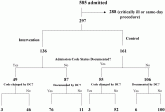Constantine A. Manthous, MD
Article

- Author:
-
Rodrigo Vazquez, MD
-
Cristina Gheorghe, MD
-
David Kaufman, MD
-
Constantine A. Manthous, MD
Article
- Author:
-
Rodrigo Vazquez, MD
-
Cristina Gheorghe, MD
-
Artur Grigoriyan, MD
-
Tatsiana Palvinskaya, MD
-
Yaw Amoateng‐Adjepong, MD, PhD
-
Constantine A. Manthous, MD
Article

- Author:
-
Shweta Upadhyay, MD
-
Andrew Beck, BA
-
Adeel Rishi, MD
-
Yaw Amoateng‐Adjepong, MD, PhD
-
Constantine A. Manthous, MD
Article

- Author:
-
Nelson Nicolasora, MD
-
Rahul Pannala, MD
-
Stavros Mountantonakis, MD
-
Bala Shanmugam, MD
-
Angela DeGirolamo, MD
-
Yaw Amoateng‐Adjepong, MD, PhD, MPH
-
Constantine A. Manthous, MD



